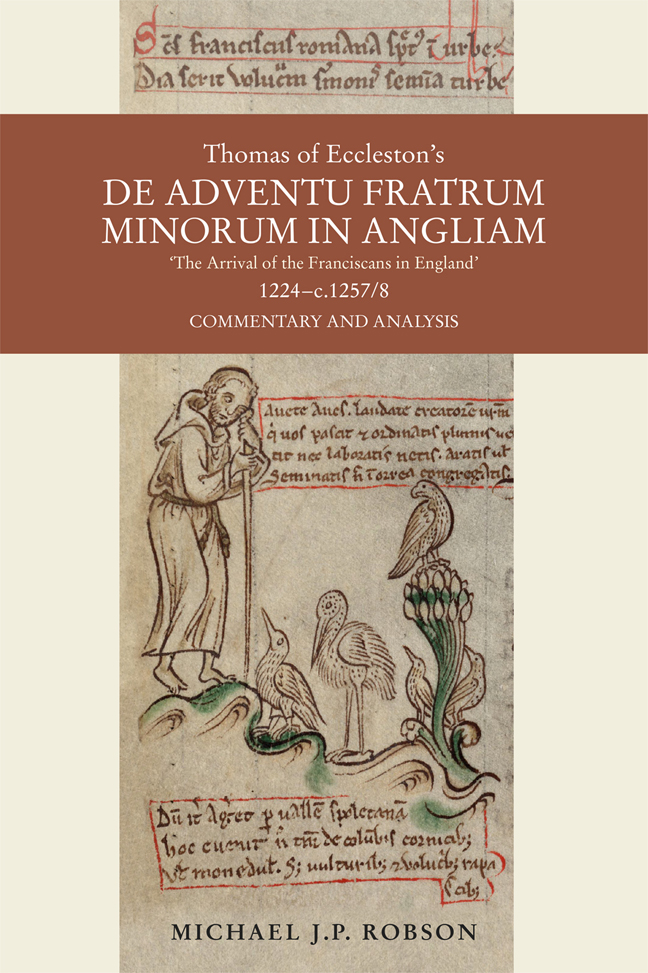Book contents
- Frontmatter
- Dedication
- Contents
- Acknowledgements
- List of Abbreviations
- Timeline
- Introduction
- 1 The launching of the mission to England
- 2 The first foundations
- 3 The admission of novices
- 4 The growth of the Franciscan community
- 5 The fervour of the early friars
- 6 The office of preaching
- 7 The seven custodies
- 8 The three general visitators
- 9 The Irish and Scottish provinces
- 10 The relocation of friaries and their enlargement
- 11 The friars’ schools of theology
- 12 The confessors
- 13 The ministers general
- 14 The ministers provincial
- 15 A gallery of friars
- A post script
- Bibliography
- Index
- Miscellaneous Endmatter
2 - The first foundations
Published online by Cambridge University Press: 02 March 2024
- Frontmatter
- Dedication
- Contents
- Acknowledgements
- List of Abbreviations
- Timeline
- Introduction
- 1 The launching of the mission to England
- 2 The first foundations
- 3 The admission of novices
- 4 The growth of the Franciscan community
- 5 The fervour of the early friars
- 6 The office of preaching
- 7 The seven custodies
- 8 The three general visitators
- 9 The Irish and Scottish provinces
- 10 The relocation of friaries and their enlargement
- 11 The friars’ schools of theology
- 12 The confessors
- 13 The ministers general
- 14 The ministers provincial
- 15 A gallery of friars
- A post script
- Bibliography
- Index
- Miscellaneous Endmatter
Summary
No sooner had the friars reached Canterbury than they split into two groups, with four proceeding to London and thereby advertising their intentions of opting for a presence in the large commercial centres. Canterbury was the ecclesiastical capital of England, the primatial see, with its galaxy of shrines, its Benedictine monasteries of Christ Church and St Augustine and various priories of canons and nuns. The city was close to the coastline and had easy communications with Northern France. London was the capital city, the seat of the royal administration and a bustling centre of commercial activity, the home of a busy port on the River Thames which exported wool to the continent. The Diocese of London was created in 604 and its cathedral church of St Paul was accompanied by as many as ninety-nine parish churches inside the city walls in the thirteenth century. There were several religious houses, beginning with Westminster Abbey, the home of a major Benedictine community which housed the shrine of St Edward the Confessor. Henry III was at work in refurbishing the saint’s tomb. Royal residences were located in the city. One friar dubbed London as the most famous and wealthy city under the sun.
London, Oxford and Northampton
Twelve Dominican friars reached London in 1221, where they constructed their first friary at Holborn from c.1223 to 1286. Eccleston affirms that the followers of St Dominic had acted benigne in receiving the Franciscans and entertaining them for fifteen days in their priory, eating and drinking with them. The followers of St Francis were treated familiarissime. Medieval chroniclers frequently link the two orders of friars with their growing chain of foundations in the cities and major boroughs of England. The Austin Friars and the Carmelites arrived and expanded in the second half of the century. The Dominicans and Franciscans lived in many of the same cities and boroughs, such as Beverley, Boston, Canterbury, Carlisle, Chester, Hereford and Winchelsea. For instance, the first two mendicant orders were frequently yoked together and selected for special commissions on behalf of the local bishop or the pope. Gregory IX dispatched two Dominicans and two Franciscans to hold theological dialogue with the leaders of the Greek Church in 1232. Later in that decade both orders were recruited to preach the Crusade. Roger Bacon described them as the ordines studentes.
- Type
- Chapter
- Information
- Thomas of Eccleston's De adventu Fratrum Minorum in Angliam 'The Arrival of the Franciscans in England', 1224-c. 1257/8Commentary and Analysis, pp. 45 - 62Publisher: Boydell & BrewerPrint publication year: 2023



